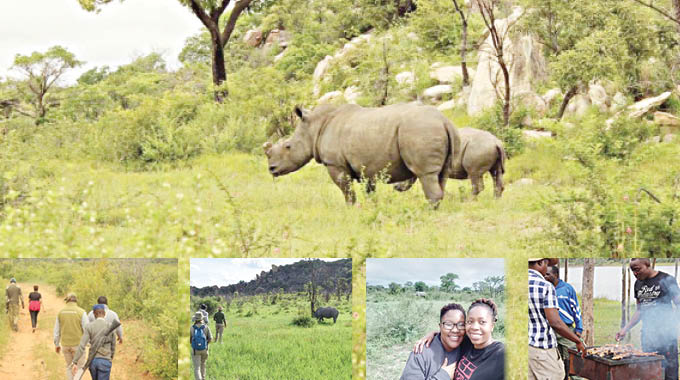
Yoliswa Dube-Moyo
“A rhino has never charged on my watch but if it happens, the trick is to stand still. You can’t outpace a rhino anyway — it runs at 45km/hour,” said Bongani, our professional guide from Bushman Safaris during a safety talk before white rhino tracking at the Matopos National Park recently.
I had my heart in my throat as I listened to him lay out the rules of the bush. We would be safe, he said, but there was always room for off tangent animal behaviour.
That thought alone spooked the life out of me — I could’ve abandoned ship altogether.
But I could tell that he was confident of our safety and could rest assured knowing that he knew what he was doing.
“Put your phones on silent mode. Stay within the group and walk in a single file. I’m being nice now, but I can be very firm once we’ve started tracking the rhinos because it’s a matter of life and death. Follow my lead and you’ll be fine,” continued Bongani as he began leading the pack into what would go down as one of the most exhilarating experiences of my life.
My heart was pulsating as we began to track this two tonne gem in the company of two armed Zimparks rangers, our guide and a couple of friends.
We were in what seemed to be the middle of nowhere with the possibility of leopards, zebra, impala and snakes springing out from any angle. The anticipation was rising and the adrenaline rush quickly mounting.
It was overcast, the perfect weather for a fast-paced walk in the bush. We were to wear closed shoes, pants, dark colours and very little perfume so as not to attract too much attention.
The golden rule was to keep the noise at a minimum, but my friends were ungovernable. They forgot this rule as soon as it was mentioned, which worried me all the more. What if we upset the animals and wound up in trouble, the paranoid me thought?
I was overthinking things. This was a premium outdoor activity and I would enjoy it, I told myself. I had soliloquies to calm myself down and had to constantly remember to breathe.
We had disembarked from our tour truck and started tracking the rhinos on foot, deep into the thicket of this part of the park.
One of the rangers had gone ahead of us to try and locate the proxemics of the rhinos using their scent and hooves engraved on the soil. Rhinos are semi-sociable, which is why guides can confidently take tourists through the bush to see them, unlike black rhinos which are more aggressive.
White rhinos are calmer and often live in small, territorial groups. Females and juveniles are rarely alone. The smell of dung grew stronger with each step and about 20 minutes into our walk, Bongani raised his hand, signalling everyone to stop. We all came to a screeching halt and the talkative suddenly went quiet.
Four mud-covered rhinos had been spotted grazing. I later learnt that they cover themselves with mud in order to keep cool.
Bongani and one of the rangers went ahead of us to assess the animals’ behaviour before we could get closer. They made whistling sounds to calm the rhino down. I found it quite fascinating to be honest. The kind of stuff you see on National Geographic!
Bongani had promised to get us as close to the rhino as possible. We waited in anticipation. He finally gave the green light and we walked closer to the rhinos, with much caution of course.
At this point, no one was talking to anyone. All eyes were on the rhinos, cameras snapping away. The rhinos continued grazing unbothered, slowly gliding across the plain. They were humungous and such a marvel to watch. It was surreal.
I had finally gotten the opportunity to see this endangered species which is slowly being driven to extinction due to poaching. Because of poaching, rhinos are protected by the State which also facilitates for their dehorning as a means of protecting them from poachers.
Using helicopters, rhinos are darted every three years so they can be dehorned. Their horns grow back just like a finger nail. A single rhino horn is worth millions of dollars. Some use them for medicinal purposes while others make various expensive art pieces and ornaments out of them.
Being the social animal that I am, I was thrilled when Bongani drew even closer to the rhinos and gave each one of us an opportunity to pose for pictures with the rhinos in the background. They gave us ample time to admire them, take pictures and learn more about them from the rangers. It was more than just an exciting walk but an educational tour too.
The rhinos started moving towards us and I for a moment thought, oh boy, but Bongani quickly stepped in to instruct us to always approach the rhino from the front and not the back.
They were not about to charge; they were probably just tired of all the attention. We had to let them be, but I was satisfied. I had tracked and walked with rhinos.
At this point, the sky had started clearing up and our track back to the tour truck began. It was time for a meal in the bush. Braaied meat and some sundowners.
